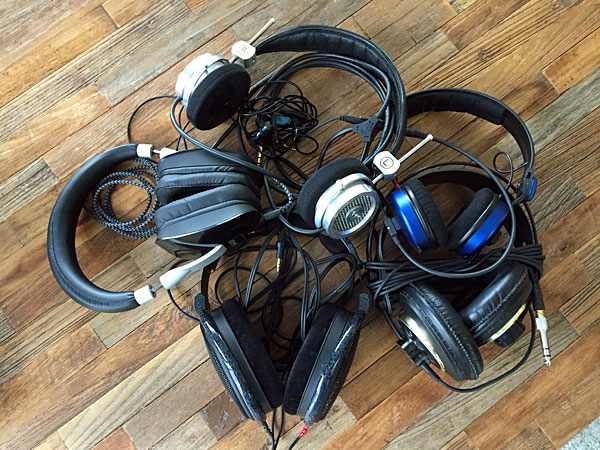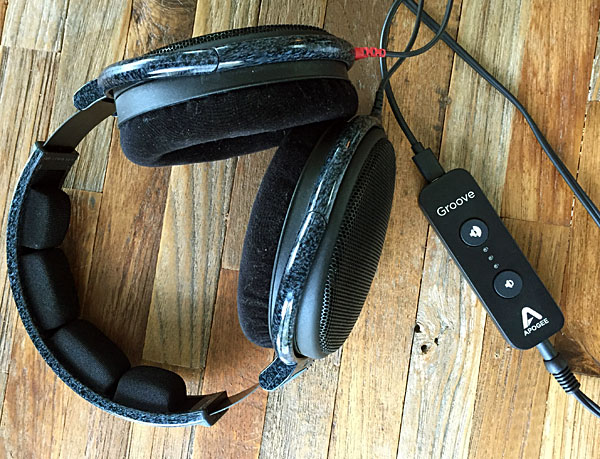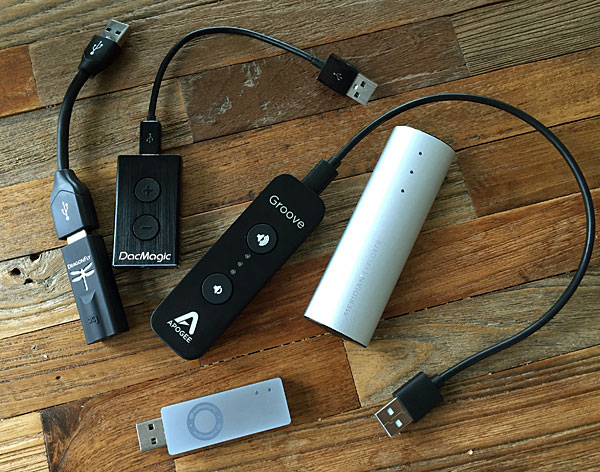| Columns Retired Columns & Blogs |
Apogee Electronics Groove D/A headphone amplifier Page 2
Current Covers
To test Apogee's claims, I listened to the Groove through a wide variety of headphones: Sennheiser Amperiors and HD600s (the latters' impedance curve is similar to that of the HD800s, which threw off the Bakoon); Ultimate Ears Triple.fi 10 in-ear monitors; my trusty Grado Labs HP 1s; NAD's Viso HP50 full-sized, circumaural 'phones; and AKG K240 studio 'phones. DAC-headphone amps included AudioQuest's DragonFly, Aurender's Flow, Cambridge Audio's DacMagic XS (all three include ESS's Sabre chip), Audioengine's Model D3, and Meridian's Explorer. And to keep them all honest, once in a while I tossed in Chord Electronics' Hugo TT.
To test Apogee's claims, I listened to the Groove through a wide variety of headphones: Sennheiser Amperiors and HD600s (the latters' impedance curve is similar to that of the HD800s, which threw off the Bakoon); Ultimate Ears Triple.fi 10 in-ear monitors; my trusty Grado Labs HP 1s; NAD's Viso HP50 full-sized, circumaural 'phones; and AKG K240 studio 'phones. DAC-headphone amps included AudioQuest's DragonFly, Aurender's Flow, Cambridge Audio's DacMagic XS (all three include ESS's Sabre chip), Audioengine's Model D3, and Meridian's Explorer. And to keep them all honest, once in a while I tossed in Chord Electronics' Hugo TT.

I picked three recordings of exceptional singers covering extraordinary songs, and began swapping headphones and DACs.
Happy Rhodes. Does anyone reading this know who she is? Anyone? Well, probably a couple of you—there's an indirect Peter Gabriel connection (Gabriel stalwarts Jerry Marotta and David Thorn have served as backing musicians on some Rhodes recordings). I searched the Stereophile website: not one mention, ever. It's one of the great mysteries of modern music why this singer-songwriter is not better known, for both her compositions and her expressive, four-octave range. She put out a string of admittedly uneven but mostly worthy albums in the 1980s and '90s before going back to her garden, somewhere in upstate New York. Poof, gone. Minimal touring, never left the country, but boy, when she was in the pocket, she created some great works.
Anyhow, I pulled up her cover of David Bowie's "Ashes to Ashes," from RhodeSongs (CD, Aural Gratification AGCD-0021): just her guitar, some electric bass, and that voice, angelic and demonic in a single song. Guitar and bass are woven together so tightly in this arrangement that at first I had trouble determining if it was a synthesized bass or an actual four-string guitar. I settled on bass guitar, and noticed that the Groove made this easier to pick out, with the Sennheiser HD600s and NAD Visos, than through those same headphones with the AQ DragonFly or Audioengine DACs. The latter two sounded a little more closed-in, and lacked the Groove's dynamics. I made it a trio of tiny tots by adding to the mix Cambridge Audio's DacMagic XS DAC-headphone amp, which came closest to the Groove—but no cigar.
One thing not apparent was any change in the sound of the bass as I plugged the Sennheiser HD600s into the Groove, and then into the other DACs: The Groove passed the Tyll Hertsens-inspired Bakoon Test. I figured Apogee's Constant Current Drive must be working, keeping the voicing of headphones intact despite their swinging impedance curves.
I pivoted to the Aurender Flow, which has an internal battery and therefore doesn't rely on USB power, and noticed just a bit more midrange dynamics and overall openness. But all of the headphones shone best through the Chord Hugo TT (also battery powered), which I raved about in the November 2015 issue. Control and dynamics popped up another notch, and each element of the mix was a tad easier to pick out. Not a fair fight—the Hugo TT costs $4795 vs the Groove's $295—but a great reality check.
I'd always thought of Christy Moore as Luka Bloom's older brother, and never really focused on his music until Philip O'Hanlon, of audio distributor A Higher Note, plopped me down in front of his system one night and played Moore's cover of Pink Floyd's "Shine On You Crazy Diamond," from his album Listen (CD, Sony BMG 88697480002). I ordered the disc straight away, and played it almost every day for a month. Moore's voice and his arrangement of this song are so perfect and touching that I find that Floyd's original—which I've always loved—now has a bona-fide equal.
The track begins with just Moore's voice, weathered and true. Then the acoustic instruments enter, one at a time, until, finally, the electric guitar solo takes us out. I've found that those first few bars can tell me plenty about a playback system. The sound is in-your-room, right there (a couple breath pops on the vocal mike were left intact), the mix revealing amazing depth and life.

Right off the bat, through the Sennheiser HD600s, the Groove revealed every detail of Moore's great voice, each breath and reverb tail clear to the end. More than with the other headphones, this combination made the microphone's own character abundantly obvious. With the DragonFly, Cambridge DacMagic, and Audioengine D3, I had to max the volume to get a proper level, and when I did, the loss of detail and, again, the compressed dynamics were apparent. Those three were out. I moved on to the Meridian Explorer.
Again, with the 300–600 ohm Sennheiser HD600s and the Meridian Explorer, I had to max the volume with this track. A bit more delicate detail returned, but the dynamics still suffered, and there was a slight brightness on vocal peaks—which suggested that Apogee's Constant Current Drive trickery might be paying off. The much-lower-impedance Grado HP1 and NAD Viso (35–38 ohms) headphones restored some volume to the Explorer, and the even-lower-impedance Sennheiser Amperiors (25 ohms) and Ultimate Ears (22 ohms) lit it up even more. In all cases, though, the Groove's sound was more dynamic, rich, and detailed.
I brought the battery-powered Aurender back to the table. Predictably, it matched the Groove in volume and dynamics, again adding a very slightly bigger overall feel to "Shine On You Crazy Diamond." Using only a USB connection to power a headphone amp clearly has its limitations, but the Groove came surprisingly close.

JitterBuggin'
By this point I was pretty sure how the DAC–headphone amps stacked up, but I wanted to try one more thing: the AudioQuest JitterBug.
I've been a bit (or two) hard on the DragonFly compared to the Groove, but this JitterBug thing is something else entirely. It noticeably tightened up the details and the top end, and pushed the Apogee into the Aurender's orbit. A couple times at the beginning of Shawn Colvin's version of Gerry Rafferty's "Baker Street," from her new album, Uncovered (CD, Fantasy 7237415), the acoustic guitarist snaps the strings à la Michael Hedges; with the JitterBug, the effect was more focused, and jumped dynamically out from the soundstage. Then the vocals and the rest of the band come in, and the space feels bigger and more natural. Who'd have thought?
Current Conclusion
What I've learned: Among the five pint-size, USB-powered DAC-headphone amps I had on hand, the Apogee Groove excelled at pushing high-impedance headphones like the Sennheiser HD600s, and just sounded better with anything I hooked up to it. Dynamics opened up, and details were more clearly defined. The Groove also benefited from being connected to the AudioQuest JitterBug ($49)—that combination, still totaling only $344, seems a no-brainer.
Even when powered by the less-than-ideal USB jack on a laptop computer, the Groove can take you into the realm of plug-in-the-wall DAC-headphone amps costing many times its price, while making it possible to use some of the trickier headphone models out there—no small feat.
- Log in or register to post comments




































